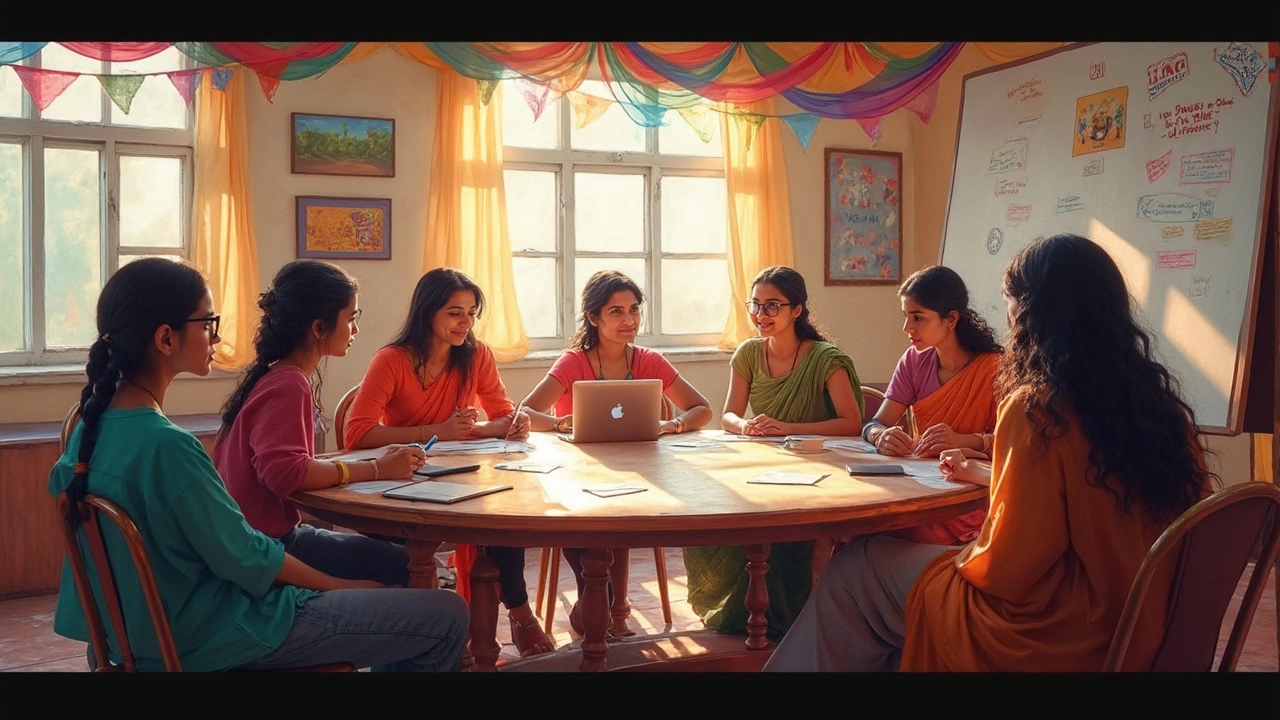Hosting a charity event isn’t about impressing everyone with a flashy venue or celebrity speakers. It’s about rallying people around one goal: making a difference. The first thing you need? Clear, honest answers—what’s the cause and what’s your real goal? Too many events flop because folks skip this step and rush to decorations and food. Are you raising money for hospital equipment, a school program, animal rescue? Nail down who you’re helping and set a number. Don’t settle for "as much as we can." If you want to raise $5,000, say it. It makes things real and gives supporters something solid to get behind.
Once your purpose is locked in, think about what will make people show up. Is a fancy dinner really right for your group—or would a backyard barbecue get more traction? Forget copying what big nonprofits do unless it fits your crowd. The trick: pick something people can get excited about but is simple enough that you and your helpers can actually pull it off. Don’t worry, you don’t need an event planner degree. Most killer charity events start with a small, scrappy team that just cares a lot.
- Getting Clear on Your Cause and Goals
- Picking the Right Theme and Format
- Finding Sponsors and Volunteers
- Spreading the Word: Easy Promotion Hacks
- Making the Big Day Run Smoothly
Getting Clear on Your Cause and Goals
If you rush through this part, your charity event risks ending up as just another forgettable night. People want to rally behind something specific, not a vague mission or unclear goal. Before you even pick a date, answer two questions: “Why are we doing this?” and “What do we want to achieve?” If you skip this, everything else is harder—selling tickets, getting donations, even getting volunteers.
Start with your cause. Maybe it’s for local kids’ sports gear, cancer research, or a food bank. Spell it out in one sentence. Don’t just say "raise money for the community"—say "raise $7,500 for new books for Oakridge Library." A crystal-clear cause helps everyone understand what’s at stake.
Now set a real, solid goal. This isn’t just about the cash, though for most fundraising events, the dollar amount matters. If you want 100 people to sign up as volunteers or get 50 first-time donors, write it down. Here’s one quick way to focus your goal:
- Decide exactly what the funds will cover (X number of meals, school supplies, or treatments).
- Estimate how much money you realistically think you can raise based on past events or similar projects. If this is your first event, ask other organizers in town what they pulled in.
- Break the goal down by ticket sales, donations, and maybe an auction—don’t lean just on one thing.
Being specific not only motivates your team but also builds trust. According to a 2023 Fidelity Charitable study, 63% of donors said they’re more likely to give when they know exactly where the money is going. That’s not a small detail—it can be the difference between hitting your target and coming up short.
| Goal Type | Why It Matters | How to Measure |
|---|---|---|
| Money Raised | Pays for the mission | Donations, ticket sales, auction totals |
| Awareness | Builds future support | Email signups, new donors, event attendance |
| Volunteers | Boosts community impact | Volunteer signups during event |
So, be brutally clear—say what you want, say why, and say how much. That’s what gets people onboard, and it’ll give your event planning a strong foundation from the start.
Picking the Right Theme and Format
Here’s where things get real: your charity event needs a theme and a format people actually care about. Don’t just slap “Casino Night” on a flyer because it sounds fancy. The best events—big and small—are the ones that match your audience’s taste and your cause’s vibe. That’s where the real connection happens.
Let’s decode this:
- If your crowd loves getting active, try a 5K run or a charity yoga morning. Health and wellness events often bring in a bigger range of ages, which means more friends chipping in.
- Want to keep things simple? Classic ideas like bake sales, trivia nights at the local bar, or a silent auction at a cozy café work surprisingly well. In the US, trivia nights can pull in $2,000 or more in one evening when you mix in raffles and entry fees.
- Working with business partners? Go for something they’ll actually attend, like a lunch-and-learn or networking breakfast. Some companies sponsor tables or offer gift match schemes for employee donations, so factor in those possibilities.
- Don’t underestimate themed dinners. One group in Texas raised over $8,000 with a simple chili cook-off—no need for a high-end ballroom.
Now, picking the right event format comes down to how much time you’ve got and the resources at hand. Want big numbers? Galas or auctions move the needle but need months to plan. Tight on time or volunteers? Go virtual. Since 2020, online events have become a power move. Virtual trivia, live-streamed concerts, and online auctions not only save money on venues, but actually expand your reach. According to Classy’s 2023 nonprofit report, online-only events brought in 26% more first-time donors compared to in-person ones last year.
| Format | Time to Organize | Average Funds Raised |
|---|---|---|
| 5K Run | 3-6 months | $5,000 – $50,000 |
| Trivia Night | 1-2 months | $2,000 – $10,000 |
| Online Auction | 1 month | $1,500 – $10,000 |
| Bake Sale | 2-4 weeks | $500 – $2,000 |
Bottom line: focus on what’s doable and what your potential attendees would genuinely enjoy. Match the theme to the crowd—and keep your main fundraising goal in sight. No one remembers a generic dinner, but everyone remembers raising money for a great cause while actually having fun.

Finding Sponsors and Volunteers
Every charity event needs support beyond your personal network. Sponsors cover costs or donate in-kind things like food or venue space. Volunteers make sure everything runs without you losing your mind. But how do you get them on board?
Start with your cause. Local businesses are more likely to chip in if they see you helping people in their community. Whether it’s the neighborhood coffee shop or a mid-sized tech firm, send a short, honest email or walk in during a slow hour with your pitch. Give them options: "Could you provide coffee for our volunteers? Would you consider a cash sponsorship?" Make it clear what’s in it for them, like logo placement on flyers or a thank you on social media.
If you want real results, don’t spam a hundred places with the same message. Target the right folks. Make a list of businesses or people who are connected to your cause or already give to other nonprofits. Use LinkedIn or even just community Facebook pages to find them. According to a 2024 survey by Double the Donation, over 70% of local businesses gave to at least one fundraising event last year, mostly in their own city or neighborhood.
Volunteers are a separate beast. You need help, but people want to know exactly what they’re signing up for. List the jobs, break them into small chunks: setup crew, greeters, social media reps the day of the event, and cleanup at the end. Post these roles on volunteer sites (like VolunteerMatch or Idealist), but also tap your friends, family, and coworkers. Be clear if you need help ahead of time or just on event day.
- Write a simple task list for each role.
- Share benefits: free food, volunteer hours for school, experience for resumes.
- Host a short kickoff meeting (can be virtual). People are more likely to show up when they hear your story in your own words.
Keep communication simple and regular. A group chat or short weekly emails work wonders to keep everyone in the loop.
And here’s a pro tip: always thank your sponsors and volunteers, loudly and publicly. Most sponsors are happy with a little recognition—think tagged Instagram posts or their name on a banner. Volunteers come back when they feel seen and valued.
Spreading the Word: Easy Promotion Hacks
Getting people in the door is half the battle for any charity event. The good news? You don’t need a huge marketing budget or a massive following—just smart moves and the right tools. First, tap into your crew’s skills. Is someone great at making Instagram reels? Let them loose. Have a cousin who’s a wizard with Canva? Design simple but eye-catching flyers for online and print.
Social media is your cheapest and fastest ticket. According to Eventbrite, 60% of people discover events on Facebook. Start a Facebook event, post sneak peeks, and get everyone on your team to share it. Tagging your sponsors or local businesses helps your event reach a bigger crowd. Use fundraising or nonprofit hashtags so people searching for ways to give back can spot you. If you have a small budget, boost a post for a few bucks—it works way better than it used to.
Email isn’t dead, either. A short note to your school, office, or church list can fill a room. Include the basics—what, when, where, why—and a clear call to action like "RSVP now" or "Donate online if you can’t make it." Attach a flyer they can forward.
Traditional methods still matter. Local newspapers and radio stations love community stories about charity events. Send them a press release—just a friendly email with your event details and a personal note about your cause. Ask your city hall or favorite coffee shop to put up a flyer. Old-school word-of-mouth (yes, literally telling people or making a group text) still fills seats.
If you want an attention-grabbing boost, think about partnering with a local business. They might let you use their space, donate snacks, or offer discounts to ticket holders. In exchange, hype them up in your event promo—everyone wins. And if you’ve got a small email list, don’t forget your personal contacts. Directly messaging a handful of people and asking them to invite two friends can snowball fast.
| Tool | Potential Audience Reach | Cost |
|---|---|---|
| Facebook Events | Up to 3,000 per local group | Free or low (ad boost) |
| Email Blasts | Depends on list size (avg. open rate: 22%) | Free |
| Local News/Radio | Thousands (community listeners) | Usually free |
| Instagram Reels/Stories | Hundreds to thousands (especially youth) | Free |
| Flyers in Businesses | Hundreds (foot traffic) | Low |
Bottom line: Use whatever tools and connections you’ve got. Stay loud, stay visible, and keep the invitation super easy to say yes to. That’s how you make your charity event the talk of the town.

Making the Big Day Run Smoothly
No matter how well you prepare, things can get messy on event day. But with a solid plan, your charity event can run without a hitch. First, check your timeline—literally, print it out and mark it up. Have backups for everything: extra pens, batteries, extension cords. Sounds extreme? Trust me, someone always forgets a cable or the mic stops working at the worst moment.
Set up early. Don’t wait for the last minute. Even if you think you’ve got hours, unexpected stuff pops up—maybe the food delivery is late or the wifi crashes. One smart move that a lot of experienced organizers swear by: a “command center” table. This is where your team can stash supplies, handle signups, and solve problems fast. It keeps everyone from panicking or running around looking for answers.
If you’re managing volunteers, make sure they know exactly where to be and what to do. It helps to use a group chat or walkie-talkies for quick updates. Emergencies happen, so have a basic first aid kit on site and appoint one person to handle any accidents.
- Print out a checklist for each area (registration, food, auction) and assign someone to double-check everything.
- Gather all payments or donations in a secure box or with a digital system. Test payment apps beforehand.
- Keep your main schedule visible for everyone—maybe on a big poster or shared doc—so nobody’s confused about what’s happening next.
- After the event, snap quick photos of people enjoying themselves (with permission, of course); these will help remind everyone why your fundraising matters and boost your promo later on.
Here’s a quick cheat sheet of typical event hiccups and easy fixes:
| Problem | Fast Fix |
|---|---|
| Tech issues (mic, speakers) | Have extra cables/batteries; assign an "AV helper" |
| No-shows (volunteers/guests) | Have at least two backup contacts on call |
| Payment app glitches | Offer paper donation forms and a secure cash box |
| Event runs late | Announce updates; skip non-essential segments |
| Weather surprises (if outdoors) | Have tents/shelters ready; move parts indoors if possible |
Small tweaks like these really can be the difference between a smooth event planning experience and total chaos. And if something goes wrong? Don’t sweat it—guests usually remember the good vibes and the impact of the nonprofit cause, not the tiny bumps in the road.





